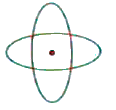Euclid stated that all right angles are equal to each other in the form of
an axiom
a definition
a postulate
a proof
The correct Answer is:C
To solve the question "Euclid stated that all right angles are equal to each other in the form of:", we will follow these steps:
1. Understand the Definition of Right Angles:
- A right angle is defined as an angle that measures exactly 90 degrees.
2. Identify the Relevant Euclidean Concepts:
- Euclid's work includes definitions, axioms, postulates, and proofs. We need to determine which category the statement about right angles falls into.
3. Recall Euclid's Postulates:
- Euclid's postulates are fundamental statements that are accepted without proof. They serve as the foundation for Euclidean geometry.
4. Locate the Specific Postulate:
- Among Euclid's postulates, the fourth postulate states that "all right angles are equal to one another." This means that if you have two right angles, they will both measure 90 degrees, and hence, they are equal.
5. Conclude the Form of the Statement:
- Since the statement "all right angles are equal to each other" is a fundamental truth in geometry and is accepted without needing proof, it is classified as a postulate.
6. Select the Correct Option:
- Therefore, the correct answer to the question is that Euclid stated that all right angles are equal to each other in the form of a postulate.
Final Answer:
Euclid stated that all right angles are equal to each other in the form of a postulate.
---
- A right angle is defined as an angle that measures exactly 90 degrees.
- Euclid's work includes definitions, axioms, postulates, and proofs. We need to determine which category the statement about right angles falls into.
- Euclid's postulates are fundamental statements that are accepted without proof. They serve as the foundation for Euclidean geometry.
- Among Euclid's postulates, the fourth postulate states that "all right angles are equal to one another." This means that if you have two right angles, they will both measure 90 degrees, and hence, they are equal.
- Since the statement "all right angles are equal to each other" is a fundamental truth in geometry and is accepted without needing proof, it is classified as a postulate.
- Therefore, the correct answer to the question is that Euclid stated that all right angles are equal to each other in the form of a postulate.
Euclid stated that all right angles are equal to each other in the form of a postulate.
Topper's Solved these Questions
- BOOK - NCERT EXEMPLAR ENGLISHCHAPTER - INTRODUCTION TO EUCLID GEOMETRYEXERCISE - Exercise 5.2 Very Short Answer Type Questions9videos
INTRODUCTION TO EUCLID GEOMETRY
- BOOK - NCERT EXEMPLAR ENGLISHCHAPTER - INTRODUCTION TO EUCLID GEOMETRYEXERCISE - Exercise 5.3 Short Answer Type Questions12videos
INTRODUCTION TO EUCLID GEOMETRY
- BOOK - NCERT EXEMPLAR ENGLISHCHAPTER - HERON'S FORMULAEXERCISE - Long Answer Type Questions8videos
HERON'S FORMULA
- BOOK - NCERT EXEMPLAR ENGLISHCHAPTER - LINEAR EQUATION IN TWO VARIABLESEXERCISE - Exercise 4.81videos
LINEAR EQUATION IN TWO VARIABLES
Similar Questions

are related to each other form?View SolutionTwo angles of an eight sided polygon are 142∘and176∘. If the remaining angles are equal to each other, find the magnitude of each of the equal angles.
View SolutionIn a polygon, there are 5 right angles and the remaining angles are equal to 195∘ each. Find the number of sides in the polygon.
View SolutionIn a polygon, there are 5 right angles and the remaining angles are equal to 195∘ each. Find the number of sides in the polygon.
View SolutionAll the angles of a quadrilateral are equal to each other. Find the measure of each. Is the quadrilateral a parallelogram? What special type of parallelogram is it?
View SolutionOne of the exterior angles of a triangle is 800 , and the interior opposite angles are equal to each other. What is the measures of each of these two angles?
View SolutionTwo coils of wires A and B are mutually at right angles to each other as shown in the figure. If the current in one coil is changed, then in the other coil
 View Solution
View SolutionThe composition of two simple harmonic motions of equal periods at right angle to each other and with a phase difference of π results in the displacement of the particle along
View SolutionIf θ1 and θ2 be the apparent angles of dip observed in two vertical planes at right angles to each other, then the true angle of dip θ is given by
View SolutionName all the angles formed in
View Solution

